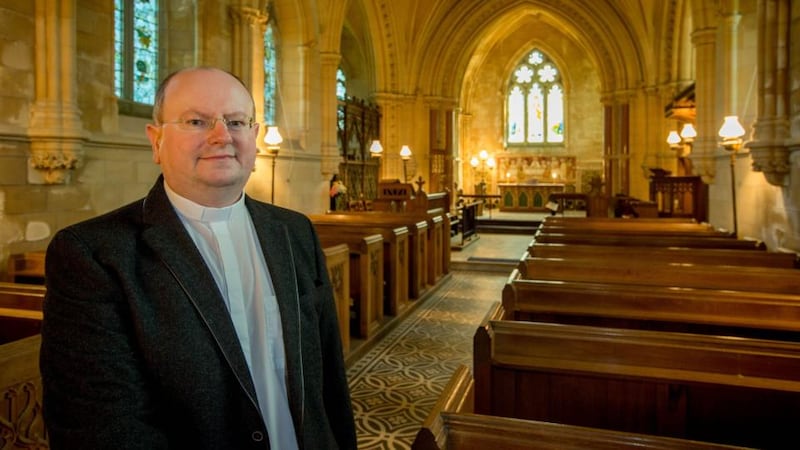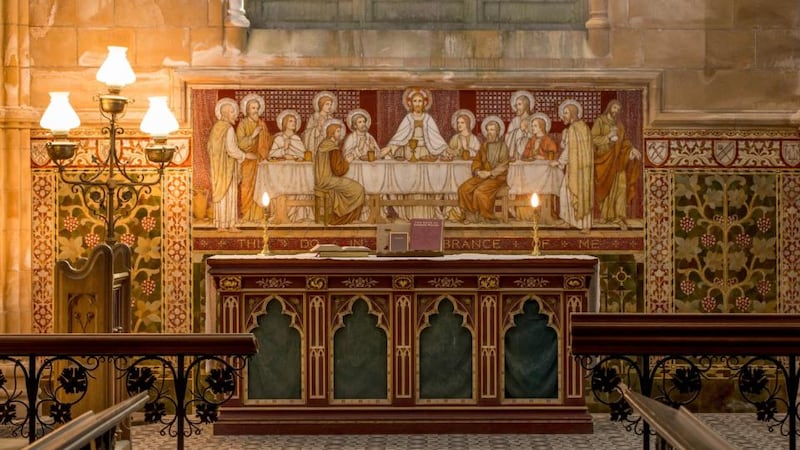'Hidden gem" may be an overused phrase, but both words are equally applicable to a small church in the Co Carlow village of Myshall, tucked into the foothills of Mount Leinster.
The beauty of the Adelaide Memorial Church of Christ the Redeemer is as breathtaking as it is unexpected. And the tragic love story behind its construction is as compelling as its craftsmanship.
A cross in an adjoining field marks the beginning of a chain of events that led, many years later, to the consecration of this Church of Ireland place of worship, which celebrates its centenary this month.


It was in this field that 25-year-old Constance Duguid, the daughter of a wealthy wine merchant living in Dover, was killed when she fell from a horse in 1887. She was engaged to a member of the Cornwall-Brady family, who lived in nearby Myshall House. One, possibly fanciful version of the incident was that a jealous former girlfriend of her fiance spooked Duguid’s horse.
Her heartbroken parents commissioned a noted sculptor of the time, Thomas Farrell, to create a statue of Innocence, carved in Sicilian white marble, to stand beside the tomb of their daughter in the Myshall graveyard. The inscription on the statue recalls the admiration with which “Conny” used to view similar monuments in Italy.
By all accounts her father, John, was a well-travelled, formidable man, standing more than six feet tall. He had been born in Buenos Aires, to a Scottish father and English mother, and raised in the manner of Spanish nobility.
Although his early adventures included riding coast to coast across bandit-country Mexico, in time he took over his father’s successful wine business, based himself in Dover and enjoyed all the trappings of success.
But, 15 years after he lost his daughter, the death of his wife, Adelaide, left John Duguid further bereft. She was laid to rest beside her daughter in Myshall, where he struck up a close friendship with the then rector, Canon Pettipiece.
Ambitious plan
An offer by Duguid to fund the reroofing of Pettipiece's church, as well as the need to erect a protective case around the weather-beaten statue of Innocence, developed into a far more ambitious plan for a new church on the site, incorporating his loved ones' tombs.
“For him it was to stand as an exemplary mark of permanence, when everything in life can be swept away,” says today’s rector in Myshall, the Rev Lester Scott. “It was to point to the glory of God and a love which reaches into eternal life.”
Duguid hired a leading ecclesiastical architect, George Coppinger Ashlin, who had worked with Edward Welby Pugin, most notably on the building of St Colman’s Cathedral, in Cobh. But the benefactor directed many of the details of the £50,000 project that was so close to his heart.
It is the combination of the grandeur of the vision and the taste with which it was executed that makes the church so exquisite.
It is often referred to as a “mini Salisbury cathedral”, the building on which it was reportedly modelled. Adelaide Memorial Church was built in the early English Gothic style, using limestone from Stradbally, in Co Laois, and transported, 15 tons at a time, by steam engine to the site.
Delightful interior features include a black-and-cream mosaic floor, striking stained-glass windows and an elegant baptistry, containing an alabaster font with inlay of lapis lazuli and mother-of-pearl.
Ten rows of carved-oak pews flank the single aisle, which leads, up a step, into the choir stalls. Polished Peterhead granite, quarried close to the Duguid ancestral home in Aberdeen, was used for the columns of the archway into the chancel, where the eye is drawn to the colourful mosaic behind the altar. Mother-of-pearl and gold leaf are used in this depiction of the Last Supper, in the style of Leonardo da Vinci.
The Duguids’ mortuary, safe from the elements, occupies the north transept, behind a wrought-iron and copper screen. And the remains of John now lie beside his wife and daughter. He died, aged 87, just months before the church was consecrated, on September 29th, 1913, so he was there only in spirit to hear the local bishop describe it as “one of the finest and most finished specimens of ecclesiastical art in Ireland”.
One hundred years later the whole community of Myshall is preparing to celebrate his legacy of love, faith and hope.
















